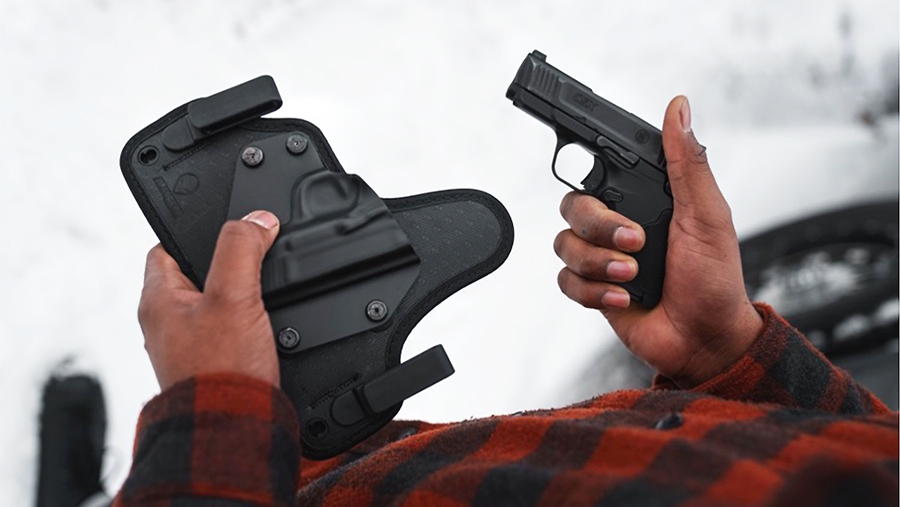Shares of Smith & Wesson Brands, Inc. were trading down about 16 percent in early-afternoon trading Friday after the company reported sales fell 31 percent in the third quarter ended January 31, well below Wall Street analyst targets.
“As you can see from the NICS data over the past three months, the firearms market, although still elevated and healthy with new entrants, has cooled significantly from the height of the pandemic surge, returning to more normal levels throughout our entire Q3,” said President and CEO Mark Smith. “And with recent results from February just released this week, now seems to be following the pre-pandemic historical demand patterns.”
The February 2022 NSSF-adjusted National Instant Criminal Background Check System (NICS) slipped 2.5 percent. NICS checks dropped 40.9 percent in January, and in December 2021, they were down 6 percent.
Smith said, “While this obviously has resulted in lower revenues from prior periods for Smith & Wesson, and no one is ever pleased to report a quarter with significant revenue declines, this macro demand pattern is very familiar to us and is exactly what our business model is designed to accommodate. I’m very proud of the team and the fact that, once again, they have demonstrated the ability to deliver meaningful profitability no matter the overall market conditions.”
Market Share Gains
Smith’s primary message was to call out Smith & Wesson’s flexibility to ramp up production to capitalize on surging firearm demand during much of the last two years but still maintain solid profitability as demand declines.
“Our manufacturing team increased throughput by over 82 percent during the surge, which has enabled us to not only gain impressive market share but also to set is a very solid business foundation for long-term success,” said Smith. He noted that since the surge in demand for firearms began in March of 2020, Smith & Wesson has paid down $160 million in debt, is now debt-free, bought back $200 million in stock, which reduced its outstanding shares by nearly 20 percent, invested nearly $40 million back into the business, and has built up a strong balance sheet with over $107 million in cash.
As demand trends normalized in the current quarter, strong gross margins, supported by higher average selling prices (ASPs), helped offset the sales decline to deliver solid profitability, albeit below last year’s demand-elevated levels. Gross margins in the quarter only fell 300 basis points despite a 31 percent decline in revenue, inflation and supply chain pressures.
Said Smith, “When demand begins to return to more normal levels, we don’t encounter the typical underutilization problem that many manufacturers would face in such a volatile market.”
The CEO further noted that gross margin and EBITDA percentages for the quarter were at the top end of its published financial guidance model and exceeded the top end fiscal year to date.
“The firearms market has always been subject to cyclicality, which is why our focus as a company has been on managing our business for the long term, sustainable growth, emphasizing safety, quality, new product innovation, and operational excellence that will endure the test of time,” said Smith.
In the quarter, sales reached $177.7 million, far off Wall Street’s consensus target of $198.29 million. On a two-year basis, sales surged 139.5 percent versus the third quarter in fiscal 2020.
The year-over-year drop reflected steeper declines in the long gun category than handguns. Sharply-lower volumes were also seen in polymer-frame pistols versus a year ago, offsetting still high demand for revolvers.
“With our top-end capacity levels being much higher than many of our competitors, we were able to refill the channel very quickly during our second quarter as demand slowed,” said Smith. “And since then, the inventory levels in the channel for our products have remained largely flat, indicating a strong sell-through of our shipments during the quarter, albeit at lower levels.”
Average Selling Prices Improve
A bright spot was average selling prices, which remain “very strong” despite the lower volumes, helped by a reduction in promotional programs combined with price and mix.
“Throughout the surge, we have been actively working to optimize our product line portfolio by rationalizing certain SKUs or occasionally entire product lines, introducing new products to replace them, and evaluating pricing across the entire line,” said Smith. “With higher ASPs from pricing and mix offsetting nearly 22 percent of the volume-related declines in the quarter, the results of those efforts are evident. While a more competitive market in the near term will likely pressure those ASPs to some degree, we do anticipate that long term, the majority of those gains will be lasting.”
During the third quarter, the mix declined 23.4 percent compared to the same period last year, while units shipped into the consumer channel declined 41.1 percent for the same period.
Deana McPherson, CFO, said on the call, “We believe the quarterly figures are not reflective of our true market position as our flexible manufacturing model allows us to quickly adjust capacity relative to changes in demand. The outsized share gains to capture as demand surge have largely endured as evidenced by viewing our results on a year-to-date basis, relative to 2020 where our sporting good shipments are up 56.3 percent versus a 25.7 percent growth in the mix.”
Gross margin in the latest period eroded 300 basis points to 39.6 percent versus 42.6 percent in the comparable quarter last year but improved 1,160 basis points from the 28.0 percent margin seen in the third quarter in fiscal 2020.
The margin decline was primarily due to the sales decline; however, other contributing factors included unfavorable absorption, inflation costs on certain labor and material payroll-related accruals associated with the planned relocation of the company’s headquarters and certain manufacturing and distribution operations to Maryville, TN. The company is moving from Springfield, MA, as a proposed law in Massachusetts seeks to prohibit the company from manufacturing certain firearms that contributed as much as 60 percent to the company’s revenue in the last financial year.
The company is on track to complete substantially by the third or fourth quarter of calendar 2023.
Price increases and favorable mix shifts were positives on margins during the quarter.
Operating expenses of $30.7 million for the third quarter were $1.4 million above the prior year comparable quarter, primarily due to $1.7 million of costs related to the planned relocation, as well as increased marketing, trade show, travel, and sales promotion costs, much of which is associated with a return to more normal business operations. Partially offsetting these increases were reduced distribution, legal and compensation-related costs.
Quarterly GAAP net income was $30.5 million, or 65 cents a share, compared with $62.3 million, or $1.12, for the comparable quarter last year. On a non-GAAP adjusted basis, net income fell 47.3 percent to $32.9 million, or 69 cents per share, missing Wall Street’s consensus estimate of 83 cents.
Non-GAAP results exclude costs related to the planned relocation, the spin-off of the outdoor products and accessories business in fiscal 2021, COVID-19-related expenses, and other costs.
Quarterly non-GAAP adjusted EBITDAS was $51.9 million, or 29.2 percent of sales, compared with $89.8 million, or 34.9 percent of sales, representing a decline of 42.2 percent a year ago.
Healthy Product Pipeline
Looking ahead, Smith said Smith & Wesson has an “impressive pipeline” of new products scheduled for launch over the next 12 months.
He said, “Just in our third quarter, we launched our much anticipated M&P chambered in 10 mm, the new CSX, a hammer-fired, full-metal frame, a concealed-carry pistol, shown lead photo, that has been well received and is in strong demand, and our Volunteer Rifle series, the next generation of our popular M&P15 rifle line. We also partnered with Vista Outdoor to co-launch its new 30 Super Carry ammunition along with our popular Shield EZ and Shield Plus, chambered for this exciting new round with ballistics comparable to the extremely popular 9 mm yet with dimensions, which allow for increased round capacity in the same firearm footprint.”
On the marketing front, brand campaigns developed around the 10 mm M&P reached over three million customers on its first day and a similar response came from content created for the CSX Volunteer and 30 Super Carry.
Looking to the current fourth quarter, inventory in the channel remained relatively stable in the third quarter, and distributors currently have approximately 18 weeks of supply across a broad range of products. McPherson said, “We believe current channel inventories are healthy, which ultimately drives positive consumer experiences by ensuring adequate supply to balance normal production levels and still meet short-term fluctuations in demand.”
With the strong inventory levels and more normalized consumer demand, Smith & Wesson expects fourth-quarter sales to return to pre-pandemic levels, implying flat sales sequentially.
Smith & Wesson expects to build internal inventory throughout its fourth quarter as it continues to restock after last year’s complete depletion of finished goods inventory.
Despite the expected reduction in sales and approximately $3 million in expenses related to the Tennessee move, Smith & Wesson still expects to meet, or exceed, financial targets set on its Analyst Day in June 2021. Goals include
- maintaining EBITDA margins of 20 percent to 30 percent,
- gross margins of 32 percent to 42 percent; and
- generating more than $75 million in cash annually.
Photo courtesy Smith & Wesson/SHOT Show 2022
















